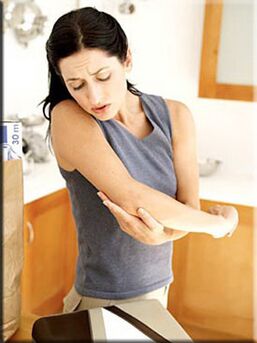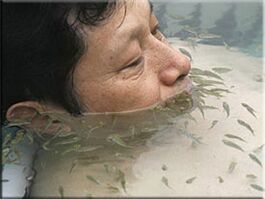Psoriasis can be manifest in many forms.Psoriasis options include vulgar (simple, regular) or, otherwise, plaque psoriasis (vulgaris psoriasis, plaque psoriasis), pustular psoriasis, drop -shaped or psoriasis psoriasis, psoriasis flexor) (flexible psoriasis).This section provides a brief description of each of the various psoriasis along with its code according to the International Classification of Disease (ICD-10).

Psoriasis is luxurious, or Normal psoriasis, rough psoriasis, simple psoriasis (vulgaris psoriasis) It is the most common form of psoriasis.It is observed in 80% - 90% of all patients with psoriasis.Luxury vulgar psoriasis are most often shown in the form of a normal area raised on healthy skin surfaces in inflamed, red, hot skin covered with gray or white silver, easy to remove, scaly, dry and thick skin.Red skin under a gray or silver layer that is easily removed and bleeding, as it contains a large number of small vessels.This field of common psoriatic damage is called psoriatic plaque.Psoriatic plaque tends to increase in size, combine with neighboring plaque, forming a whole plate plate ("paraffin lake").
Flexible surface psoriasis (bending psoriasis), or "Reverse psoriasis". Usually it looks smooth, does not peel or with a minimal area, the inflammatory red spots that do not stand out on the surface of the skin, located exclusively in the folds of the skin, without the absence or minimum wound of other areas of the skin.Often, these forms of psoriasis affect the folds of the outer genital organs, on the thighs, on the inner surface of the hip, axillary curves, folds under abdominal obesity (psoriatic pannus), and on the skin of the skin under the mammary gland in women.These forms of psoriasis are very vulnerable to deterioration under the influence of friction, skin and sweat injuries, and are often accompanied or complicated by secondary fungal infections or streptococcal pyoderma.
Psoriasis Guttate (Psoriasis Guttate) It is characterized by the presence of small amounts, enlarged on a healthy, dry, red or purple skin surface (up to purple), which is similar to a shape for falling, tears or small dots, circular elements -wounds.These psoriatic elements usually strengthen the large surface of the skin, the most frequent hips, but can also be seen on the feet, arms, shoulders, hair, back, neck.Land -shaped psoriasis often develop or worsen after streptococcal infections, in cases of normal - after streptococcal tonsilitis or streptococcal pharyngitis.
Pustular psoriasis or Psoriasis Exudation It is the worst of the psoriasis skin and looks like bubbles or blisters that are enlarged on a healthy skin surface, filled with unfortunate and transparent inflammation (pustules).The skin below and above the surface of the pustules and around it is red, hot, edematous, inflamed and thick, easy to peel.The secondary infection of the pustules can be observed, where exudate has a purulent character.Pustulous psoriasis can be restricted, local, while the most frequent localization is the distal end of the limbs (arms and legs), that is, lower leg and lower arm, this is called palmoplantar pustules (palmoplantah pustulosis).In other cases, pustular psoriasis can be adjusted, with widespread spread of pustules throughout the body and the tendency to join into larger pustules.
The cause of psoriasis
Impaired skin barrier functions (in particular, mechanical or irritation, friction and pressure on the skin, soap and detergent abuse, contact with solvents, household chemicals, alcohol -containing solutions, presence of infected focus on skin or skin allergy, excess dry skin) also play a role in the development of psorias.
Psoriasis - This is in many ways idiosinratic skin disease.The experience of most patients shows that spontaneous psoriasis can improve or, in turn, worsen for no apparent reason.Studies on various factors related to the emergence, development or severity of psoriasis tend to be based on small studies, usually hospitals (not outpatients), that is, heavier, patients with psoriasis.Therefore, these studies often experience inadequate sample representation and from the inability to identify causal relationships with the presence of large numbers (including unknown or unknown) that can affect the nature of psoriasis.Often, in different studies, conflicting findings are found.However, the first signs of psoriasis often occur after stress (physical or mental), skin damage in the place of the first appearance of psoriatic rash, and/or transferred streptococcal infections.The situation, according to some sources that can contribute to the disadvantages or worsening psoriasis, including acute and chronic infections, stress, climate change and seasonal changes.Some drugs, in particular, lithium carbonate, beta-blockers, antidepressants, antimalarial drugs, anticonvulsants, according to some sources, are associated with deterioration of psoriasis or can even cause its main occurrence.Excessive use of alcohol, smoking, weight gain or obesity, improper nutrition can be heavy psoriasis or complicates its treatment, causing problems.Hair varnish, some creams and handles for hands, cosmetics and perfumes, household chemicals can also cause psoriasis problems in some patients.

Patients with HIV or AIDS infection often experience psoriasis.This is as if it is a paradoxical for psoriasis researchers, as treatment aimed at reducing the number of T cells or their activities generally helps treat psoriasis, and HIV infection or, moreover, AIDS is accompanied by a decrease in the number of T.Bad.In addition to this puzzle, HIV infection is usually accompanied by a strong cytokin profile shift towards TH2, while vulgar psoriasis in unpredictable patients are characterized by a strong transition from the cytokin profile towards TH1.According to the current adopted hypothesis, reduced volume and altered activity of CD4+ T-lymphocytes in patients with HIV or AIDS infection cause CD8+ T-lymphocytes, which is responsible for the development or hunting of psoriasis in infected HIV or patients with AIDS.However, it is important to know that most patients with psoriasis are healthy in relation to HIV transport, and HIV infection is responsible for less than 1 % of psoriasis cases.On the other hand, psoriasis in HIV-infected people occur, according to various sources, with a frequency of 1 to 6 %, which is about 3 times higher than the frequency of psoriasis in the general population.Psoriasis in patients with HIV infection and especially AIDS often occur very difficult, and are not good or not at all in accordance with standard therapy methods.
Psoriasis most often develop in patients with dry, thin skin, sensitive to patients with oily or good skin, and more common in women than men.In the same patients, the most common psoriasis appears in dry or thin skin areas of oily skin, and especially often appear in places of damage to the integrity of the skin, including melting, scratching, scratches, wounds, places that suffer from friction, pressure or contact with aggressive chemicals, detergent, detergent, detergent, detergent, detergent.(This is called the phenomenon).It is considered that the phenomenon of this lesoride psoriasis is mainly with dry, thin or injured skin related to the fact that the body infects (probably most frequent streptococcus) can easily penetrate the skin with minimal secretion of skin fat (which, under other conditions, protects the skin from infection) the best condition for psoriasis development is the best for the development of the foot infection ("For the development of fungal infections, the best skin, wet, for psoriasis, on the contrary, dry.which in turn causes symptoms of psoriasis characteristics, such as itching and increased skin cell germination.This, in turn, leads to increased dryness of the skin, both due to inflammation and increased keratinocyte germination, and due to the fact that the infected body uses moisture, which will instead function to moisturize the skin.To prevent excessive dryness of the skin and reduce the symptoms of psoriasis, patients with psoriasis are not recommended to use washing cloth and scrubs, especially rigid, as they not only damage the skin, leave microscopic scratches, but also scrape from the cornea of the top and skin, which protects the skin from drying from drying from drying.It is also recommended to use talcum or baby that has after washing or bathing to absorb excess moisture from the skin, which, otherwise, will "get" the infected agent.In addition, it is recommended to use products that moisturize and feed the skin, and lotions that improve the function of the sebum gland.It is not recommended for soap abuse, detergent.You should try to avoid skin contact with solvents, household chemicals.
Diagnosis of psoriasis
Diagnosis of psoriasis is usually simple and based on the appearance of skin characteristics.There are no diagnostic procedures or blood tests specific to psoriasis.However, with active psoriasis, progressive or severe courses, deviations in blood tests can be found, confirming the presence of active inflammation, autoimmune, rheumatic processes (improving rheumatoid factors, acute phase protein, leukocytosis, ESR improvement, and sometimes. Sometimes skin biopsy is required to exclude other skin diseases and diagnosis.Psoriasis, tears of tears called retail, keratinocyte layers, their histological inaccuracies, large skin infiltration with t-lymphocytes, macrophages and dendritic cells, signs up.and the ease of bleeding from the skin under the plaque during its filming, which is associated with the acceleration of angiogenesis and increased permeability pathologically and fragile skin vessels in the wound (aushpitz symptoms).
Alternative treatment of psoriasis
For the treatment of coarse psoriasis symptoms, some countries in some countries use ichthyotherapy in several resorts with open thermal springs.The Garra Rufa fish living there eats skin on psoriatic plaques, without touching healthy areas.After such treatment, an improvement in the patient's condition is observed by six months or more.Successful locations in the subtropics allow you to combine rest in a comfortable hotel room with fish spa procedures and sea baths.At your request, the hotel cook will provide a special diet.Water in the bath with Garra Rufa fish past the three -station cleaning system (mechanical, ultraviolet sterilization and biological purification).The sun, the sea, the fresh air, the special diet-all of these complexes help to achieve the positive effects of bathing by fishing.Daily sparks with a mixture of powdered sugar and potato starch will help eliminate psoriatic plaque.
Psoriasis treatment with folk remedies
- To overcome psoriasis, Let go of fat, pork, smoking, chocolate, spices, alcohol, coffee and sugar -gula.Enhancing diet with boiled milk products, fresh herbs, baked apples, fish and salad salads.Eat lots of vegetable oils rich in fatty acids) and products containing lecithin.
- Eat food In stew, boiled or boiled (exempt fried and smoke) from diet.
- Rejecting foods that increase acidity in the body- Give priority to alkaline products.Some people on the web have repeatedly testified that only alkaline changes in alkali contribute to complete health recovery, not only from the psoriasis itself, but also the old chronic diseases.
- Wash Only children's soap or tar, regularly shower with decoctions of celandine, hops and three -color violets.
- Follow Surgery (hunger 1-2 days).























